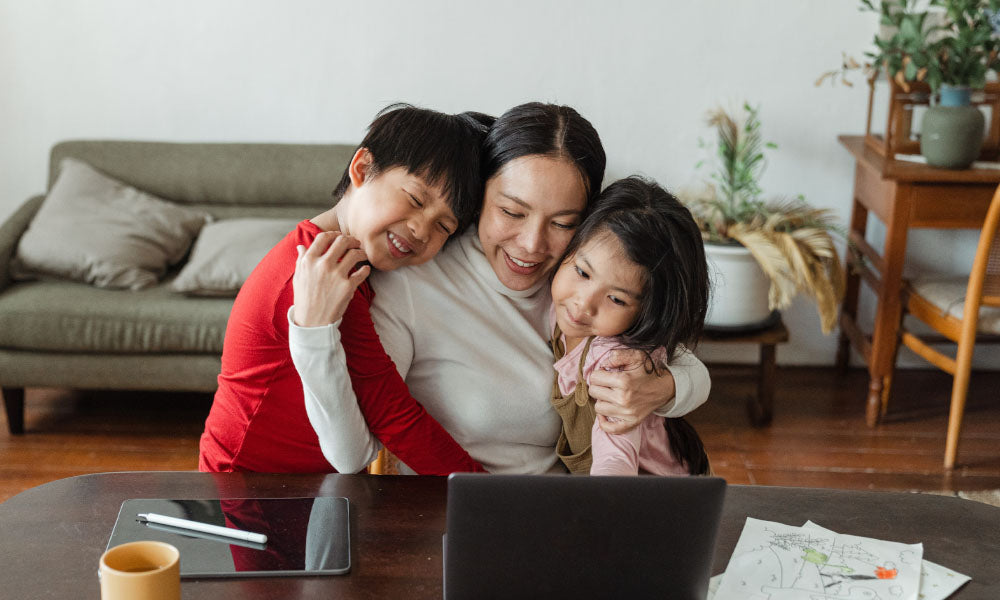I have a game I sometimes play when I’m alone. I stand in front of the bathroom sink, deliberately leaving off my contacts. I have terrible vision, so I always end up squinting at my blurry reflection in the mirror. Then I tell myself that I can’t control my vocal cords, so no words are allowed to escape my lips. I’m also not allowed to use my hands in any meaningful way, so no signing, pointing, grasping, or waving. Once the scene is set, I imagine I have a problem. I have a terrible itch. My throat hurts. I’m hungry. There’s a loud sound making my head pound. The game ends as I picture my husband coming into the room to find me there with my burning problem. Without hands, a voice, or my full vision, how will I let him know what I need? How will he know what to do to help me?
I don’t play this game because I’m a complete weirdo. I do it because I want to understand my youngest daughter. Because while this is a nightmare scenario for most of us, it is her everyday reality. My four-year-old, JJ, has a vision impairment. She’s also non-verbal and can’t control what her hands do most of the time. To say her means of communication are limited is being generous.
JJ has a rare genetic disorder called Rett Syndrome. It causes loss of speech and purposeful hand use, as well as seizures, anxiety, breathing problems and several other serious issues. Since the onset of JJ’s symptoms and her diagnosis, my life has transformed dramatically. Many of these adjustments have been quite painful, but one thing has changed for the better: I’ve learned to view communication in a new and fascinating light. I’ve discovered the depth and breadth of the world that exists beyond words.
When it comes to the ways people communicate with one another, I—like most people—have always focused more on output than input. What kind of vocabulary, intonation, and accent does someone have? What words do they choose? What kind of conversationalist are they? JJ only has six garbled versions of words, so her output is almost non-existent. But I’ve learned what a mistake it can be to ignore her input. This is precisely where she excels.
Like most people with Rett Syndrome, JJ understands everything happening around her. Because of this, I always talk to her directly, explain what things mean, and tell her our plans for the day. When I mention things like going to the doctor or taking yet another Covid test, she lets out screeches of displeasure. When I talk about fun and exciting things—her grandmother coming to visit or an upcoming birthday party—JJ smiles, laughs, or bounces up.
She Loves music, so I often expand her vocabulary through song lyrics. I explain a new word to her, then tell her to show me that she recognizes it. When she hears the word in the song, JJ will look at me intently or widen her eyes. She’s a sponge, soaking up all the words floating around her.I’ve been surprised by the full spectrum of emotions my daughter can express. Before JJ, I didn’t have a good idea of what “non-verbal” meant. But if there’s one thing I’ve learned, it’s that non-verbal doesn’t mean silent. JJ has a vast repertoire of sounds and, if you pay attention, they can tell you a lot about her mood. She has joyful shouts, irritated groans, angry bellows, and bored whines. Even though she can’t control her vocal cords well enough to form words, she always finds ways to make her feelings known.
JJ has learned to answer yes/no questions, and I’ve been shocked at how far this one skill can get someone. During a long afternoon of potato chip bribery, I taught her to look intently at me to indicate yes and to turn her head away to say no. This simple action has opened up a world of possibilities. JJ used to scream, bite, or cry to indicate a problem. Now, she can tell me if she is in pain, where the pain is, and if she wants medicine for it. I also know when she is hungry, that she had a good day at school, and which song she’d like to hear from her playlist.
Never underestimate the power of yes and no. JJ’s speech therapist told me about a fifteen-year-old boy working at grade level thanks to the use of yes/no questions. After my experiences with JJ, the story didn’t really surprise me.
Through my daughter, I’ve discovered how important it is to think creatively about communication. After working with an occupational therapist, JJ learned to hit very large, brightly-colored buttons with her hands. I wanted to maximize this skill, so I bought a set of buttons that hold up to thirty seconds of recorded sound. Then I secured them to JJ’s moveable gait trainer.
Now, as she walks around the house, my daughter has access to her favorite songs, as well as to some pre-recorded phrases. She pushes the I-want-to-eat button when she is hungry and the Pay-attention-to-me button when I leave the room or talk to someone else for too long. (She is a toddler, after all). One of my favorite phrases was recorded by my oldest daughter on the day of her sister’s fourth birthday party. Our guests definitely got a kick out of watching JJ wheel around pushing her Party-mobile-coming-through button.
Since JJ’s diagnosis, I’ve been surprised at how much can be communicated by certain parts of the body. Like JJ, most people with Rett Syndrome can’t use their voice or hands. So they use their eyes to talk instead. They rely on everything from picture symbol cards velcroed to a sheet of plastic, to high-tech eye-gaze devices that type out words. Some children learn to read and write, do their homework, or even graduate from high school thanks to the power of their eyes. It’s time-consuming and tiring, but it gives them a voice and allows them to be heard.
We’re hoping someday JJ will be able to do this too, but we have to start simply. For now, she practices looking at picture cards to indicate what she wants, with certain measures in place to maximize her vision. She has a black background to simplify her visual field and the color contrasts that catch her attention best. We also place the cards close to her face. It will be a long road to a high-tech eye-gaze device, but we’re doing everything in our power to get her there.
Everyone deserves to be seen, heard, and understood by the rest of the world. But thanks to JJ, I’ve learned that what this looks like can vary widely. If we expand our ideas about what it means to speak and to listen, there are so many ways we can tap into people’s thoughts and feelings. I’m hopeful there will come a day when my daughter can communicate her wants and needs to me through an augmentative communication device. But until then, I’m focusing on the most important lesson I’ve learned so far—that if two people are determined to “talk” to each other, they will always find a way.



